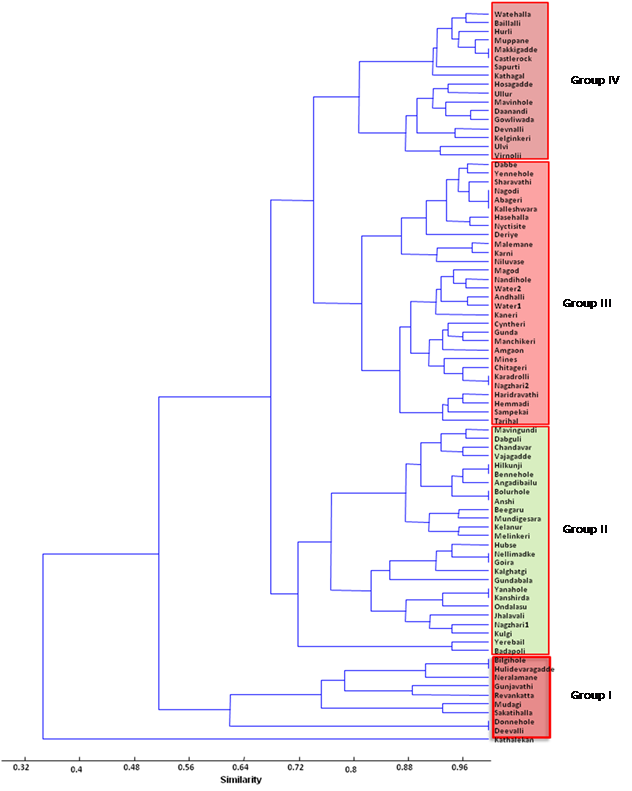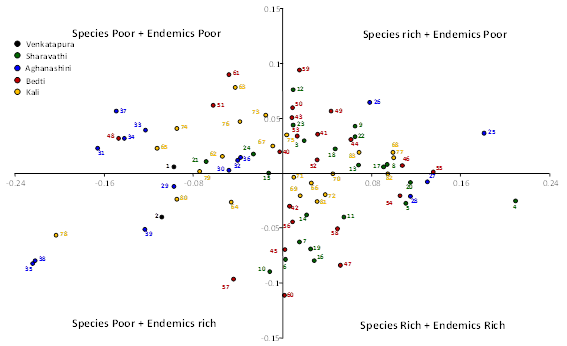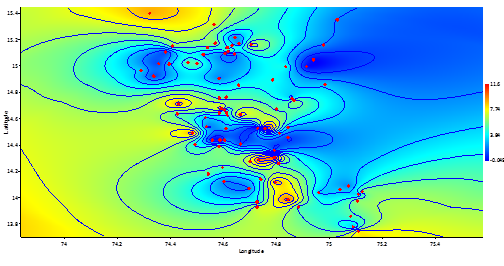Back |
RESULTS |
Next
|
Amphibian diversity and distribution across Uttara Kannada district: Forty seven species of amphibians were recorded from Uttara Kannada district (Table 3). This is nearly 30% of observed amphibians from the Western Ghats (157 species). These species belonged to two orders, nine families and 20 genera. Two families, namely, Nyctibatrachidae and Micrixalidae are among the oldest frog families found in the Western Ghats and are Gondwanan relicts. Of the 46 species recorded, 67% of them are endemic to the Western Ghats (31 species). Family Dicroglossidae has highest species (15) followed by Rhacophoridae with 10 species. Least species were recorded in Ranixalidae and Ichthyophiidae with two each (Table 4).
Table 3. Species recorded and their ecological status in the four river basins of Uttara Kannada.
Species |
Common name |
Endemic |
IUCN |
CLASS: AMPHIBIA Gray |
|||
Family: Bufonidae Gray |
|||
Duttaphrynus melanostictus (Schneider 1799) |
Common Indian toad |
Non endemic |
LC |
Duttaphrynus scaber (Schneider, 1799) |
Ferguson’s toad |
Non endemic |
LC |
Duttaphrynus stomaticus (Lutken, 1862) |
Assam toad |
Non endemic |
LC |
Pedostibes tuberculosus Günther 1875 |
Malabar Tree toad |
Western Ghats |
EN |
Family: Dicroglossidae Anderson |
|||
Euphlyctis aloysii Joshy, Alam,Kurabayashi, Sumida and Kuramoto, 2009 |
Aloys’ skittering frog |
Western Ghats |
DD |
Euphlyctis cyanophlyctis (Schneider, 1799) |
Skittering frog |
Non endemic |
LC |
Euphlyctis hexadactylus (Lesson, 1834) |
Indian Pond frog |
Non endemic |
LC |
Fejervarya brevipalmata (Peters, 1871) |
Peter’s frog |
Western Ghats |
DD |
Fejervarya caperata Kuramoto, Joshy, Kurabayashi |
Wrinkled Fejervarya |
Western Ghats |
DD |
Fejervarya granosa Kuramoto, Joshy, Kurabayashi |
Granular Fejervarya |
Western Ghats |
DD |
Fejervarya kudremukhensis Kuramoto, Joshy, |
Kudremukha Fejervarya |
Western Ghats |
DD |
Fejervarya mudduraja Kuramoto, Joshy, Kurabayashi |
Mudduraja Fejervarya |
Western Ghats |
DD |
Fejervarya rufescens (Jerdon, 1853) |
Reddish burrowing frog |
Western Ghats |
LC |
Hoplobatrachus crassus (Jerdon, 1853) |
Jerdon’s bull frog |
Non-endemic |
LC |
Hoplobatrachus tigerinus (Daudin, 1803) |
Indian bull frog |
Non-endemic |
LC |
Minervarya syhadris Dubois, Ohler and Biju, 2001 |
Minervarya frog |
Western Ghats |
EN |
Sphaerotheca aff. leucorhychus (Rao, 1937) |
Rao’s burrowing frog |
Western Ghats |
DD |
Sphaerotheca breviceps (Schneider, 1799) |
Indian Burrowing frog |
Non-endemic |
LC |
Sphaerotheca dobsonii (Boulenger, 1882) |
Dobson’s burrowing frog |
Western Ghats |
LC |
Family: Micrixalidae Dubois, Ohler and Biju |
|||
Micrixalus aff. elegans (Rao, 1937) |
Elegant torrent frog |
Western Ghats |
DD |
Micrixalus saxicola (Jerdon, 1853) |
Small torrent frog |
Western Ghats |
VU |
Family: Microhylidae Günther |
|||
Kaloula taprobanica Parker, 1934 |
Painted frog |
Non-endemic |
LC |
Microhyla ornata (Dumeril and Bibron, 1841) |
Ornate narrow mouthed frog |
Non-endemic |
LC |
Microhyla rubra (Jerdon, 1854) |
Red narrow mouthed frog |
Non-endemic |
LC |
Ramanella aff. Montana (Jerdon, 1854) |
Jerdon’s Ramanella |
Western Ghats |
NT |
Family: Nyctibatrachidae Blommers-Schlösser |
|||
Nyctibatrachus cf. aliciae Inger, Shaffer, Koshy |
Alice’s Night frog |
Western Ghats |
EN |
Nyctibatrachus cf. major Boulenger, 1882 |
Malabar Night frog |
Western Ghats |
VU |
Nyctibatrachus cf. petraeus Das and Kunte, 2005 |
Castle rock night frog |
Western Ghats |
LC |
Family: Ranidae Rafinesque |
|||
Clinotarsus curtipes (Jerdon, 1853) |
Bicoloured frog |
Non-endemic |
NT |
Hylarana aurantiaca (Boulenger, 1904) |
Golden frog |
Western Ghats |
VU |
Hylarana malabaricus (Tschudi,1838) |
Fungoid frog |
Non-endemic |
LC |
Hylarana temporalis (Günther,1864) |
Bronzed frog |
Non-endemic |
NT |
Family: Ranixalidae Dubois |
|||
Indirana beddomii (Günther, 1875) |
Beddome’s Indian frog |
Western Ghats |
LC |
Indirana semipalmatus (Boulenger,1882) |
South Indian frog |
Western Ghats |
LC |
Family: Rhacophoridae Hoffman |
|||
Polypedates maculatus (Gray, 1834) |
Chunam frog |
Non-endemic |
LC |
Polypedates occidentalis Das and Dutta, 2006 |
Charpa tree frog |
Western Ghats |
DD |
Polypedates pseudocruciger Das and Ravichandran, |
False hour glass tree frog |
Western Ghats |
LC |
Pseudophilautus amboli (Biju and Bossuyt, 2009) |
Amboli bush frog |
Western Ghats |
DD |
Pseudophilautus wynaadensis (Jerdon, 1853) |
Wynaad bush frog |
Western Ghats |
EN |
Raorchestes bombayensis (Annandale, 1919) |
Maharashtra bush frog |
Western Ghats |
VU |
Raorchestes luteolus (Kuramoto and Joshy, 2003) |
Coorg yellow bush frog |
Western Ghats |
DD |
Raorchestes ponmudi (Biju and Bossuyt, 2005) |
Large Ponmudi bush frog |
Western Ghats |
CE |
Raorchestes tuberohumerus (Kuramoto and Joshy, 2003) |
Kudremukh bush frog |
Western Ghats |
DD |
Rhacophorus malabaricus Jerdon, 1870 |
Malabar gliding frog |
Western Ghats |
LC |
ORDER: GYMNOPHIONA Müller |
|||
Family: Ichthyophiidae Taylor |
|||
Ichthyophis beddomi Peters, 1879 |
Beddome’s caecilian |
Western Ghats |
LC |
Ichthyophis bombayensis Taylor, 1960 |
Bombay caecilian |
Western Ghats |
DD |
Note: E-endemic; NE-non-endemic; GAA-GlobalAmphibian Assessment; EX-Extinct from type locality; EN-Endangered; Vu-Vulnerable; NT-Near threatened; LC-Least concerned, DD-Data deficient |
|||
Table 4. Family wise species recorded in Uttara Kannada
Family |
Genera |
Species |
Bufonidae |
2 |
4 |
Dicroglossidae |
5 |
15 |
Micrixalidae |
1 |
3 |
Microhylidae |
3 |
4 |
Nyctibatrachidae |
1 |
3 |
Ranidae |
2 |
4 |
Ranixalidae |
1 |
2 |
Rhacophoridae |
4 |
10 |
Ichthyophiidae |
1 |
2 |
River basin wise diversity of Amphibians: Amphibian species recorded in each of the river basin in given in Table 5. There were 45 species from Sharavathi, 32 from Aghanashini, 29 each from Bedti and Kali river basins and five species in Venkatapura river.
Sharavathi river basin: Forty five species were recorded from Sharavathi river basin listed in Table 5. Majority of the species recorded for the entire Uttara Kannada district is known from Sharavathi river basin, except for Raorchestes bombayensis. Sharavathi harbours nearly 69% of endemic species of the Western Ghats. The species rich sites (> 10 species) are Kathalekan (34 species), Watehalla and Muppane (14 species each), Hurli (12 species) and Niluvase (11 species). Kathalekan is a well known Myristica swamp having ancient origin (Chandran et al 2010), and provides habitat for uniquely breeding species (Gururaja, 2010). It also has highest number of endemic species (24). Raorchestes ponmudi, an endangered species is also recorded from this site.Aghanashini river basin: Thirty two species are recorded from Aghanashini river basin (Table 5). None of the caecilians were recorded in this river basin. Kathagal with 17 species is species rich site in Aghanashini followed by Sapurthi (15 species) and Baillalli (13 species). Sapurthi harbours higher endemic species in the entire river basin.Bedti river basin: Twenty nine species were recorded from Bedti river basin. Species rich regions are Makkigadde (13 species), Devnalli (12 species), Kelginkeri and Daanandi (10 species each). Endemism is highest is Makkigadde and Devnalli (8 species each). It is interesting note that Yerebail has no endemic species despite having 6 species.
Kali river basin: Kali river basin has 29 species (Listed in Table 5). Castle rock, Virnolli and Ulvi are species rich (13 species each) followed Gowliwada (10 species). Castle rock leads with higher endemism than Ulvi (6 endmic species) Virnolli (9 endemic species). The species recorded from Deriye were all endemic to Western Ghats.
Table 5. River basin wise species record in Uttara Kannada.
|
Sharavathi |
Aghanashini |
Bedti |
Kali |
Venkatapura |
Family: Bufonidae |
|
||||
Duttaphrynus melanostictus |
+ |
+ |
+ |
+ |
|
Duttaphrynus scaber |
+ |
+ |
+ |
+ |
|
Duttaphrynus stomaticus |
+ |
|
+ |
|
|
Pedostibes tuberculosus |
+ |
+ |
+ |
+ |
|
Family: Dicroglossidae |
|
||||
Euphlyctis aloysii |
+ |
|
|
+ |
|
Euphlyctis cyanophlyctis |
+ |
+ |
+ |
+ |
+ |
Euphlyctis hexadactylus |
+ |
+ |
|
|
|
Fejervarya brevipalmatus |
+ |
|
|
|
+ |
Fejervarya caperata |
+ |
+ |
+ |
+ |
|
Fejervarya granosa |
+ |
+ |
+ |
|
|
Fejervarya kudremukhensis |
+ |
|
+ |
+ |
|
Fejervarya mudduraja |
+ |
+ |
|
|
|
Fejervarya rufescens |
+ |
+ |
+ |
+ |
|
Hoplobatrachus crassus |
+ |
+ |
|
|
|
Hoplobatrachus tigerinus |
+ |
+ |
+ |
+ |
|
Minervarya syhadris |
+ |
+ |
+ |
+ |
+ |
Sphaerotheca aff. leucorhychus |
+ |
+ |
|
+ |
|
Sphaerotheca breviceps |
+ |
+ |
+ |
+ |
|
Sphaerotheca dobsonii |
+ |
|
|
|
|
Family: Micrixalidae |
|
||||
Micrixalus aff. Elegans |
+ |
|
|
|
|
Micrixalus saxicola |
+ |
+ |
+ |
|
|
Family: Microhylidae |
|
||||
Kaloula pulchra |
+ |
|
|
+ |
|
Microhyla ornata |
+ |
+ |
+ |
+ |
|
Microhyla rubra |
+ |
+ |
+ |
+ |
|
Ramanella aff. Montana |
+ |
|
|
+ |
|
Family: Nyctibatrachidae |
|
||||
Nyctibatrachus cf. aliciae |
+ |
+ |
+ |
|
+ |
Nyctibatrachus cf. major |
+ |
+ |
|
|
|
Nyctibatrachus cf. petraeus |
+ |
+ |
+ |
+ |
|
Family: Ranidae |
|
||||
Clinotarsus curtipes |
+ |
+ |
+ |
+ |
|
Hylarana aurantiaca |
+ |
+ |
+ |
+ |
|
Hylarana malabaricus |
+ |
+ |
+ |
+ |
|
Hylarana temporalis |
+ |
+ |
+ |
+ |
|
Family: Ranixalidae |
|
||||
Indirana beddomii |
+ |
+ |
+ |
+ |
|
Indirana semipalmatus |
+ |
+ |
+ |
+ |
+ |
Family: Rhacophoridae |
|
||||
Polypedates maculatus |
+ |
+ |
+ |
+ |
|
Polypedates occidentalis |
+ |
+ |
|
|
|
Polypedates pseudocruciger |
+ |
|
|
|
|
Pseudophilautus amboli |
+ |
|
+ |
+ |
|
Pseudophilautus wynaadensis |
+ |
+ |
|
+ |
|
Raorchestes bombayensis |
|
|
+ |
+ |
|
Raorchestes luteolus |
+ |
+ |
+ |
|
|
Raorchestes ponmudi |
+ |
|
|
|
|
Raorchestes tuberohumerus |
+ |
+ |
|
+ |
|
Rhacophorus malabaricus |
+ |
+ |
+ |
+ |
|
Family: Ichthyophiidae |
|
||||
Ichthyophis beddomi |
+ |
|
|
|
|
Ichthyophis malabaricus |
+ |
|
+ |
|
|
Species richness |
45 |
32 |
29 |
29 |
5 |
Cluster analysis based on species richness and endemics using Bray-curtis distance measure is given in Figure 7. There are four clear groups with Kathalekan standing out exceptionally. Group I is species poor, while Group IV is species rich. Non-metric multidimensional scaling analysis based on habitat variables and species parameters are given in Figure 8. All the 83 sampling sites can be categorically grouped into four. Each quadrant in the graph are representing a unique group. First quadrant carries species rich but endemic poor group, II Quadrant having both richness and endemism very poor, III Quadrant with species poor but endemic rich and IV Quadrant with species rich and endemic rich sites. Kathalekan, Watehalla and Muppanne in Sharavathi, Baillalli in Aghanashini, Kelginkeri in Bedti are in Quadrant IV, needing immediate conservation measures. These sites were also influenced by arboreal species richness, direct developing species, critically endangered and endangered species.

Figure 7. Cluster analysis based on species richness and endemism.

Figure 8. Non-metric multidimensional analysis of amphibians of Uttara Kannada.

Figure 9. Spatial interpolation using krigging based on species endemism.
Krigging based on species endemism is given in Figure 9. Kathalekan is being deliberately removed from the analysis to know other sites in the Uttara Kannada district with higher endemism. The warm coloration and contours joining them indicates the endemism value. Sites like Castle rock in Kali, Makkigadde in Bedti, Kathagal, Sapurthi and Bailalli in Aghanashini and Maleman, Nagodi and Hurli in Sharavathi river basin along with Kathalekan are species rich and endemics rich